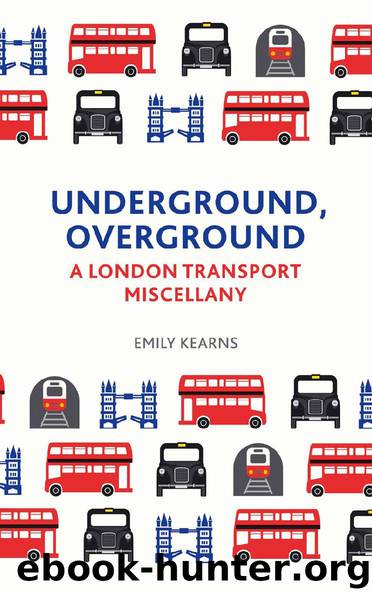Underground, Overground by Emily Kearns

Author:Emily Kearns
Language: eng
Format: epub
Publisher: Summersdale Publisher
Fleet size: 30
Tram frequency: 12 an hour
Stops: 39
Annual passenger count: 29 million
Mainline stations served: 7
Major bus routes served: 50+
Tube stations served: 1
Trolleybuses
The trolleybus, or the trackless trolley/tram, is exactly that: an electric bus that draws its electricity, using spring-loaded poles, from the wires overhead. Unlike a tram, the trolleybus does not operate on a set of tracks and actually looks remarkably like a standard bus. At its peak, the trolleybus system in London prided itself on being the largest in the world, with 68 routes. Trolleybuses enjoyed their heyday in the 1930s and 1940s, replacing the ‘outdated’ tram, before they too were elbowed out of the way by the petrol-powered beasts that make up the bus fleets of the capital.
Timeline
1882 – In a Berlin suburb, Dr Ernst Werner von Siemens trials the world’s first trolleybus. The trial lasts for around five weeks and the project is abandoned.
1889 – The Ward Electrical Car Company is formed in Britain with a view to building and operating electric-battery buses.
1900 – This year sees further experimenting with trolleybuses, when Frenchman M. Lombard-Gérin launches his vehicle to tie in with the Paris Exhibition of 1900.
1901 – German Max Schiemann opens for business the world’s first passenger trolleybus service in Bielatal, near Dresden.
1909 – The first trolleybus in Britain runs under tramway wiring in Birkenhead, but despite trials, the trackless tram doesn’t catch on in the northwestern town.
1914 – By this year, there are seven trolleybus networks operating in Britain: in Aberdare, Bradford, Keighley, Leeds, Ramsbottom, Rotherham and Stockport.
1931 – The first trolleybuses are brought into operation in London. The fleet of 60 vehicles (which are nicknamed ‘diddlers’) is operated by London United Tramways – and so begins the phasing out of London’s trams.
1933 – The newly formed London Transport rules that all trams are to be replaced with trolleybuses.
1948 – A new batch of trolleybuses is introduced to replace those destroyed or damaged during the war.
1954 – A decision is made to replace all trolleybuses with petrol-powered buses; these are phased in until the early 1960s, when all trolleybus services in the capital cease.
People of note
Download
This site does not store any files on its server. We only index and link to content provided by other sites. Please contact the content providers to delete copyright contents if any and email us, we'll remove relevant links or contents immediately.
| Automotive | Engineering |
| Transportation |
Small Unmanned Fixed-wing Aircraft Design by Andrew J. Keane Andras Sobester James P. Scanlan & András Sóbester & James P. Scanlan(32693)
Navigation and Map Reading by K Andrew(4974)
Endurance: Shackleton's Incredible Voyage by Alfred Lansing(4635)
And the Band Played On by Randy Shilts(2091)
The Box by Marc Levinson(1905)
Top 10 Prague (EYEWITNESS TOP 10 TRAVEL GUIDES) by DK(1903)
Wild Ride by Adam Lashinsky(1903)
The Race for Hitler's X-Planes: Britain's 1945 Mission to Capture Secret Luftwaffe Technology by John Christopher(1773)
The One Percenter Encyclopedia by Bill Hayes(1764)
Trans-Siberian Railway by Lonely Planet(1670)
Girls Auto Clinic Glove Box Guide by Patrice Banks(1657)
Looking for a Ship by John McPhee(1611)
Batavia's Graveyard by Mike Dash(1588)
TWA 800 by Jack Cashill(1571)
Fighting Hitler's Jets: The Extraordinary Story of the American Airmen Who Beat the Luftwaffe and Defeated Nazi Germany by Robert F. Dorr(1549)
Good with Words by Patrick Barry(1547)
Troubleshooting and Repair of Diesel Engines by Paul Dempsey(1534)
Bligh by Rob Mundle(1525)
Ticket to Ride by Tom Chesshyre(1524)
